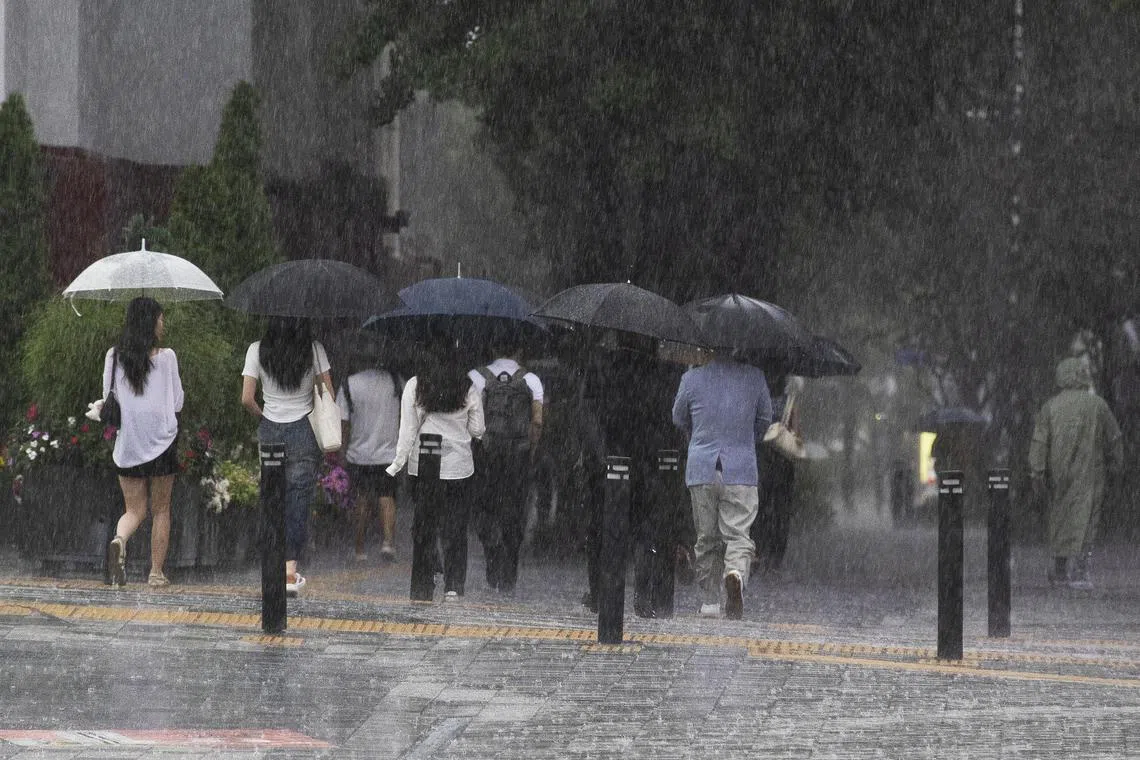Heavy rain hits South Korea’s Seoul, Gyeonggi
Sign up now: Get ST's newsletters delivered to your inbox

People walk with umbrellas amid heavy rain at Gwanghwamun Square in Seoul, South Korea, on July 17.
PHOTO: EPA-EFE
Follow topic:
SEOUL - South Korea remained on high alert for torrential downpours on July 17 as heavy rains hit the Seoul metropolitan area and parts of northern Gyeonggi province, causing rush-hour traffic disruptions and home evacuations.
Heavy rains of 100.9mm per hour battered Munsan in Paju, Gyeonggi Province, for an hour until 7.03am (local time), while Singok-dong in Uijeongbu, just north of Seoul, received 103.5mm of rain for an hour from 6.22am.
Nearly 300 reports regarding heavy rains had also been reported to the Gyeonggi Bukbu Provincial Police’s 112 situation room as at 9am on July 17, of which 200 cases have been addressed, officials said.
Residents in Nowon-gu in northern Seoul, Jungnang-gu in eastern Seoul, and Guri in Gyeonggi Province were alerted at around 9.33am, as more than 50mm of rain was hitting the area.
Meanwhile, the weather agency predicted that heavy rains would continue to drench much of the nation until July 18, with some regions forecast to receive up to 200mm of rain.
The state weather agency on July 17 issued its first emergency text message warning of torrential rains in 2024 for the Seoul metropolitan area and parts of northern Gyeonggi Province.
The Korean Meteorological Administration directly issues heavy rain alerts when rainfall exceeds 50mm per hour, 90mm in three hours or when the hourly precipitation rate surpasses 72mm.
The alerts inform people to stay alert during hazardous weather conditions and swiftly evacuate if necessary. Officials said six heavy rain alerts were sent in 2023 to the greater Seoul area.
Flood advisories had also been issued in Seoul’s ten districts as at noon on July 17: Gangdong, Gangseo, Eunpyeong, Mapo, Jongno, Seodaemun, Seongbuk, Gangbuk, Songpa and Nowon districts.
The entrances to 29 streams within the capital area were restricted, and the Dongbu Arterial Road and four parking stations along the river were closed at around 8.45am.
Restrictions for seven streams were lifted, and the Dongbu Arterial Road also reopened later in the day as the water levels of the nearby streams went down.
The weather agency forecast that 30mm to 60mm of heavy rains and up to 70mm of rain per hour, accompanied by strong winds, thunder and lightning, will hit the metropolitan region, the northern part of Gangwon Province and northern parts of North Chungcheong Province, from the afternoon of July 17 to the morning of July 18.
Hundreds of people evacuated their homes as massive monsoon rains hammered the country.
A total of 407 households and 560 residents nationwide had relocated to nearby areas for safety reasons as at 11am, according to the Central Disaster and Safety Countermeasure Headquarters.
No casualties had been reported as at press time.
Torrential rains also led to disruptions in train operations.
Korea Railroad Corp said on July 17 that it had suspended operations between Mangwolsa Station and Deokjeong Station on the Gyeongwon Line for 50 minutes due to the rain.
Korail’s operating guideline states that trains wait at the nearest stations when rainfall exceeds 65mm per hour. It resumed operations at around 8.50am.
To prevent flooding in the area, the Korea Hydro and Nuclear Power Co opened the two floodgates in Chuncheon at noon to discharge up to 250 tonnes of water per second so that the water could flow downstream and adjust the dam’s water level.
At the same time, the nearby Uiam Dam also opened its floodgates to release up to 500 tonnes of water per second. THE KOREA HERALD/ASIA NEWS NETWORK

